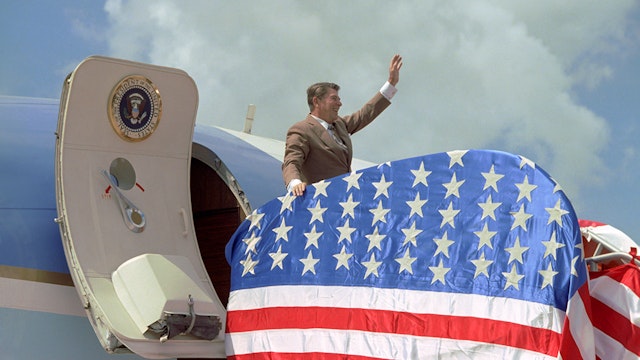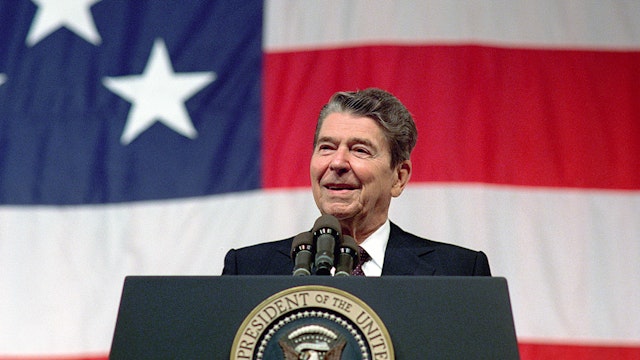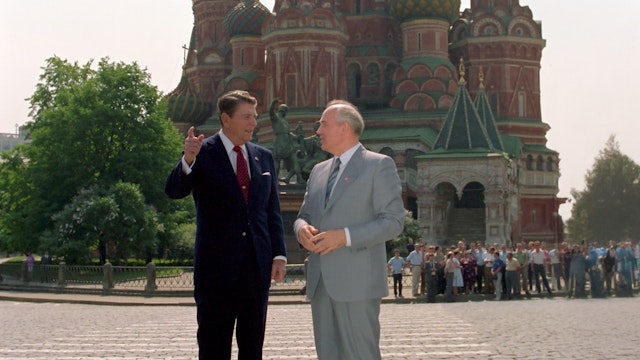The Presidency
Economic Policy
The Reagan Revolution
When Ronald Reagan took the oath of office as America’s 40th President on January 20, 1981, the country was experiencing some of the bleakest economic times since the Depression. Taxes were high, unemployment was high, interest rates were high, and the national spirit was low.
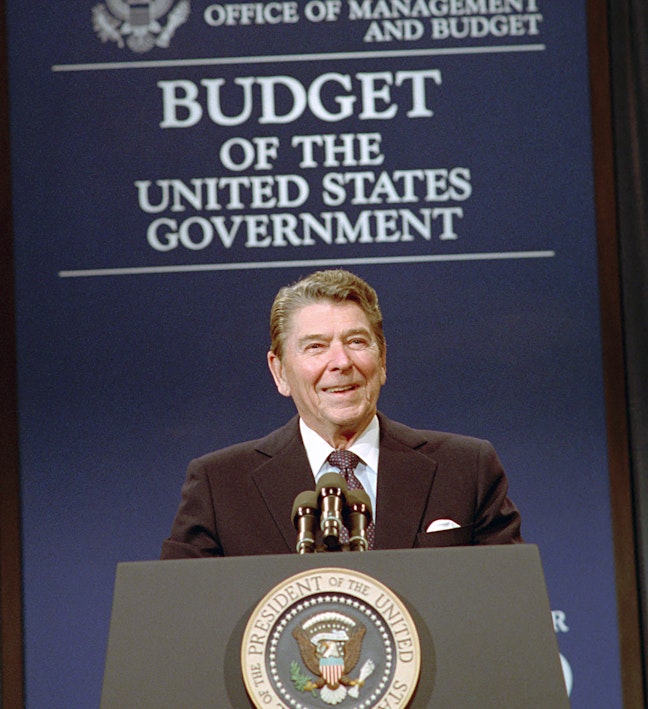
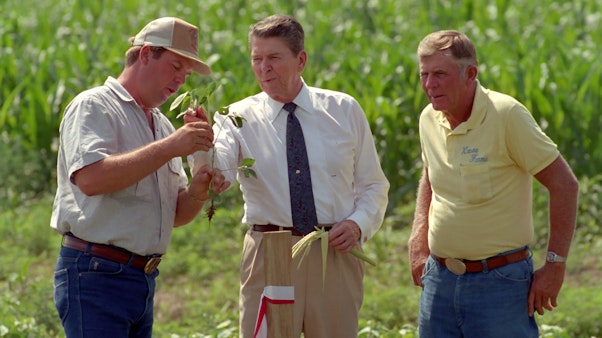
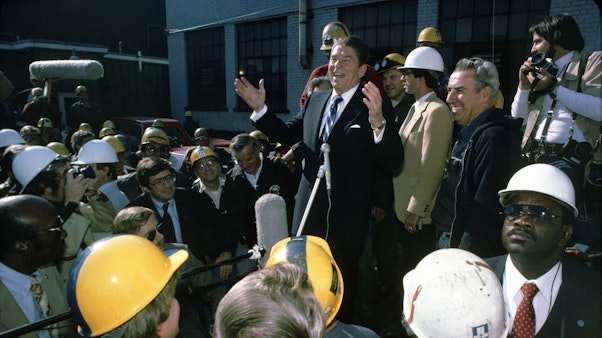
"A Healthy, Vigorous, Growing Economy"
To reverse the economic climate of the time, President Reagan put forth an economic policy which aimed to reduce government regulation, lower taxes, and promote free-market capitalism as a means to stimulate economic growth and increase individual wealth.
Bringing America back was the new President’s top priority and he shared his vision in his Inaugural Address. Watch President Reagan's Inaugural Address below.
President Reagan's Inaugural Address
The Foundation For A Path Forward
President Reagan earned a degree in Economics at Eureka college, and even though he would sometimes joke about “two economists having three opinions,” he knew what needed to be done and how to do it.
He consistently advocated for a straightforward and simple, yet detailed plan during his campaign: cut taxes, get control of government spending, and get the government out of the way so that the entrepreneurial spirit of the American people could be unleashed.
Despite skeptics labeling his plan as "Reaganomics," President Reagan remained resolute, recognizing that empowering individuals with financial resources and investment incentives would lead to job creation, inflation control, and reduced interest rates.

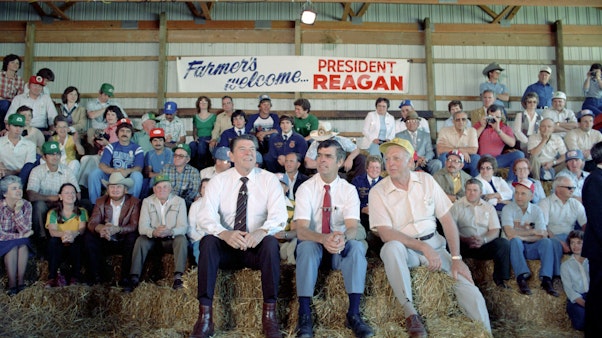
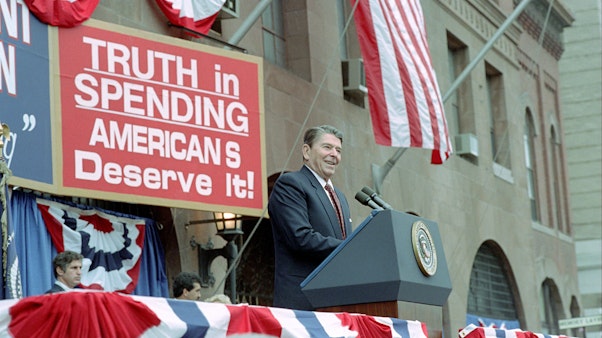
Passing Legislation and Putting The Economy Back On Track
Almost as soon as the Inaugural ceremony was over, President Reagan set his sights on Capitol Hill. From day one, he and his team worked tirelessly to get Congress to pass legislation to put the economy back on track.
Even a near-fatal assassination attempt did not slow him down. While still recovering, he summoned Congressional leaders to the White House to twist their arms. Ronald Reagan may have been the first President to wear pajamas to a meeting with the bipartisan Congressional leadership. He wanted them to know he meant business.
His efforts paid off. In August 1981, President Reagan signed the Economic Recovery Tax Act of 1981, which brought reductions in individual income tax rates, the expensing of depreciable property, incentives for small businesses, and incentives for savings.
So began the Reagan Recovery and a few years later, the Tax Reform Act of 1986 brought the lowest individual and corporate income tax rates of any major industrialized country in the world.
The Numbers Tell the Story
Over eight years the Reagan Administration achieved the following:
20 million new jobs were created
The combination of tax cuts and deregulation was a catalyst for economic growth and job creation. Several industries experienced expansion, including finance, technology, and manufacturing. During this expansion, business had more capital and flexibility, which led to job creation.
Inflation dropped from 13.5% in 1980 to 4.1% by 1988
Through fiscal restraint, reduced government spending, tax reforms, deregulation, and economic growth, the decline in inflation helped create a more stable economy, boosting business confidence and investment.
Unemployment fell from 7.6% to 5.5%
As President Reagan's policies were implemented, economic growth began to take off. This favorable economic environment allowed businesses to thrive and expand, thus creating more jobs and lowering unemployment.
Net worth of families earning between $20,000 and $50,000 annually grew by 27%
Economic expansion, tax cuts, and job growth were primarily drivers of increasing the net worth of families earning between $20,000 and $50,000. Also contributing to this growth was asset appreciation and inflation moderation.
Real gross national product rose 26%
As Reagan's economic policies began taking off this ultimately led to a substantial rise in Gross National Product (GNP), reflecting increased productivity, business expansion, and investment.
The prime interest rate was reduced to 10% by August, 1988
The Reagan administration slashed the prime interest rate by more than half, from an unprecedented 21.5% in January 1981 to 10% in August 1988. This achievement stemmed from the administration’s shift in monetary policy aimed at controlling inflation and stimulating economic growth.
By The Numbers
The First Hand Results of the Reagan Recovery
$9,000 Reagan tax cuts saved the median-income two-earner American family of four close to $9,000 in taxes
25%Employment of African-Americans rose by more than 25% between 1982 and 1988
50%More than half of the new jobs created went to women
1%Government spending growth dropped from 10% in 1982 to just over 1% in 1987
10+ YearsAfter adjusting for inflation, federal spending actually decreased for the first time in over a decade
The American Miracle
So impressive was the Reagan Recovery that at the G7 Economic Summit in 1983, when it was obvious the President’s plan was working, the West German Chancellor asked him to “tell us about the American miracle." That was quite a turnaround from two years earlier, when President Reagan outlined his economic recovery plan to an unconvinced group of world leaders.
Now, however, they all wanted to know how he did it, so he told them: reducing tax rates restored the incentive to produce and create jobs, and getting government out of the way allowed people to be entrepreneurs. From there, the free marketplace operated as it was supposed to.


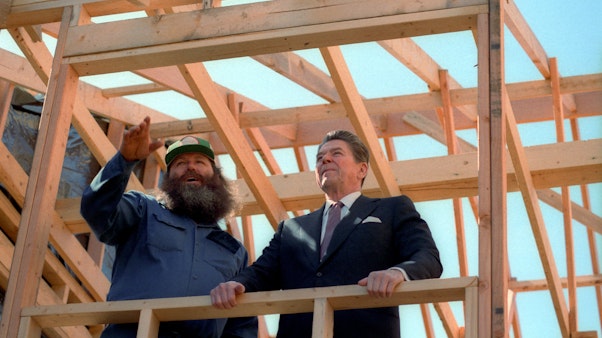
The American Dream Restored
As President Reagan observed with a wry smile, “I could tell our economic program was working when they stopped calling it Reaganomics.” But what really pleased him most about the Reagan Recovery was not the vindication or all the impressive statistics. To him, the success of Reaganomics was what it brought to the American people.
Millions had good jobs and were able to keep more of the money for which they worked so hard. Families could reliably plan a budget and pay their bills. The seemingly insatiable Federal government was on a much-needed diet. And businesses and individual entrepreneurs were no longer hassled by their government, or paralyzed by burdensome and unnecessary regulations every time they wanted to expand.
In a phrase, the American dream had been restored.
“This Administration’s objective will be a healthy, vigorous, growing economy...”
January 20, 1981
This Administration’s objective will be a healthy, vigorous, growing economy that provides equal opportunities for all Americans, with no barriers born of bigotry or discrimination. Putting America back to work means putting all Americans back to work. Ending inflation means freeing all Americans from the terror of runaway living costs. All must share in the productive work of this ’new beginning,’ and all must share in the bounty of a revived economy.
— Excerpted from Inaugural Address

